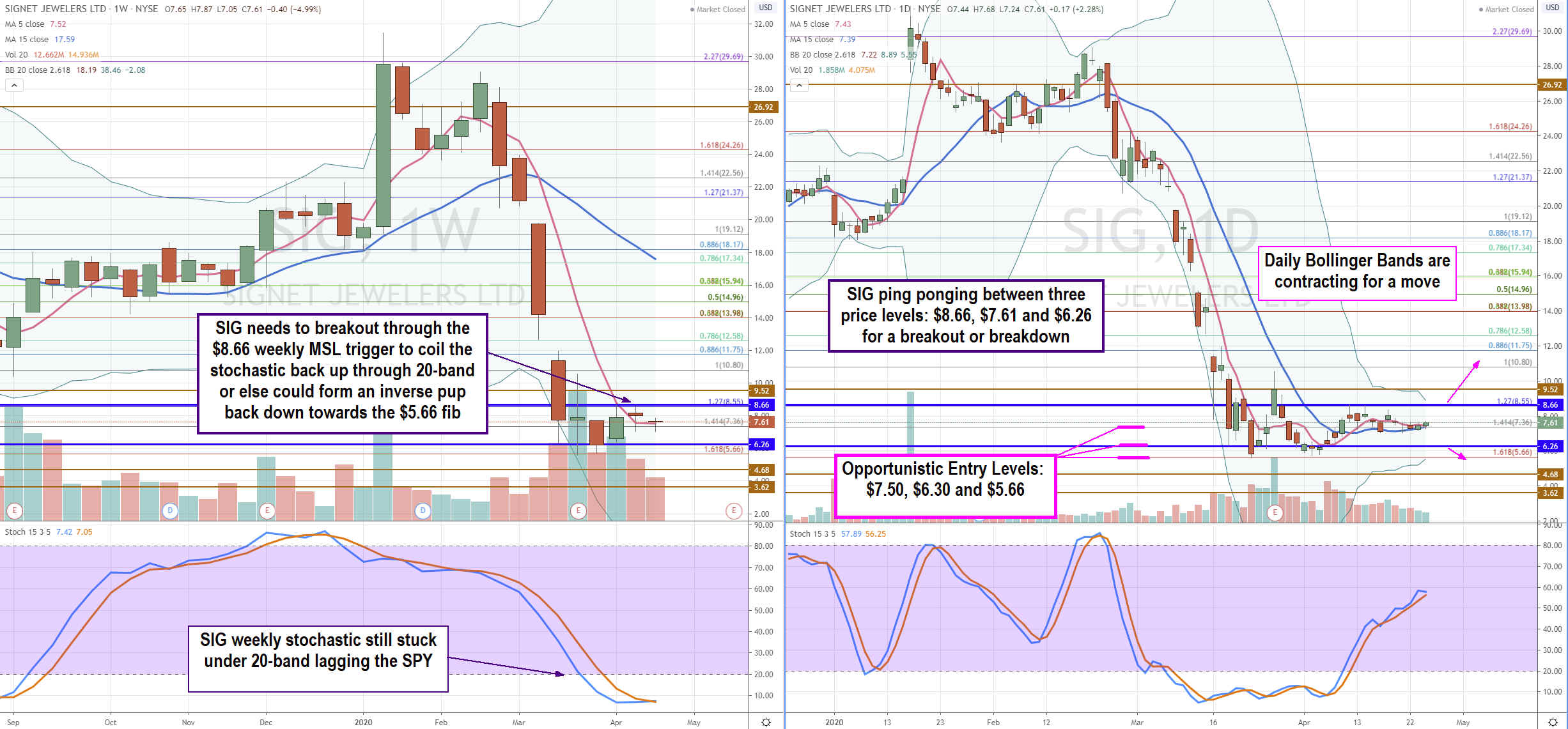World’s largest publicly traded jewelry retailer
Signet Jewelers (NYSE: SIG) shares fell (-82%) off its highs of $31.44 on Jan. 16, 2020, before coiling back to the $7.50s range. The COVID-19 pandemic triggered a (-35%) plunge in the
S&P 500 (NYSEARCA: SPY). While the SPY has recovered over half its losses, Signet continues to flounder trading (-75%) off its highs. The market has lumped Signet in the same box as mall-based retail department stores like
Macy’s (NYSE: M) ,
The Gap (NYSE: GPS) and
Nordstrom (NYSE: JWN) . While Signet may rely on the same customer foot traffic, it is in a better position to recover as economies start to re-open under the restart narrative. Investors may want to take notice of this value play while it’s still in the proverbial “bargain bin” at opportunistic entry levels.
Takeaways from Signet Q4 FY 2020 Results
Signet released its Q4 fiscal year 2020 results (for the quarter ending Dec. 31, 2019) on March 26, 2020. The company reported same-store sales (SSS) up +2.3% worldwide and up +2.9% in the U.S. January 2020 comp SSS were up 1.6% compared to prior guidance of (-4% to – 2%). Signet reported non-GAAP EPS of $3.67 versus guidance of $3.44 to $3.52 range. This resulted in non-GAAP operating income growth of 16% generating free cash flow of $419 million. This was the best holiday season performance in four-years. This sent shares spiking 32%. Management made it very clear that the results were pre-COVID-19 pandemic and they were consciously taking proactive measures moving forward to beef up the balance sheet and cut expenses to weather the temporary closures.
Proactive Defensive Strategy
While the March through April comps are expected to be devastating with most U.S. store temporarily closed. Management outlined the defensive measures taken to survive through the lean period where stay-at-home orders have frozen business across the nation. Management voluntary implemented 50% salary cuts to be distributed through stock compensation to protect cash. The company tapped its revolver for $900 million to beef up cash position to $1.2 billion. Retail store employees have been furloughed and dividends have been temporarily suspended, further protecting $19.4 million in cash per quarter. The payroll and expense savings further protects its cash position as the company continues to evaluate the permanent closure of more locations.
The Restart Narrative
As locations start to re-open, the company can provide better forecasts as well as pay back unused portions of the revolver. As it stands, the interest on the $900 million is 2.8% resulting in $25.2 million in annual interest fees. Management hopes to reconvene the Path to Brilliance transformation strategy. The company seeks to continue trimming store sizes and retail store footprints to smaller, higher growth potential stores delivering a full omni channel customer journey. The silver lining is that 35-to-40% of total sales and all profits occur during the fourth quarter holiday season. In addition to the pent-up demand, the Q4 FY2021 should produce a slingshot type sales spike if the COVID-19 pandemic passes by then. While Signet traditionally provides financing for jewelry purchases the $1.2 billion cash position is healthy enough to buy time through the business freeze and the $3.2 billion long-term debt. It is interesting to note that only 7% of their customer financing is non-prime. Shares are trading at a price-earnings (P/E) ratio of 5.44 compared to an average P/E of 12.5. Compare that to competitor Tiffany & Co. (NYSE: TIF) trading at a P/E of 28.39.

Opportunistic Buy Levels
Using the rifle charts on wider time frames to lay out the playing field is suitable for swing traders and investors. SIG formed a weekly market structure low (MSL) trigger above $8.66 and a daily MSL trigger above $6.26. The weekly stochastic commenced it oscillation down through the 80-band at the beginning of 2020 and proceeded to collapse through the 20-band and presently remaining under the 10-band. The daily stochastic has been rigorously trying to oscillation higher with stair-step mini pups to force the weekly stochastic to cross up and bounce. The weekly 5-period moving average (MA) sits at $7.52 just above the $7.36 Fibonacci (fib) level. SIG is chopping between the weekly and daily MSL triggers and the $7.36 fib. The very oversold weekly stochastic can trigger a squeeze on the 20-band coil up or a breakdown if the daily stochastic slips taking the share under through the daily MSL trigger. There are three opportunistic entry levels: $7.50 stinky 2.50s zone/fib, $6.30 daily MSL trigger and $5.66 fib. Nimble traders can scalp these levels initially for reversion and then with the intraday trend. Swing traders can scale for overnight to multi-day holds. Long-term investors may consider a dollar-cost averaging approach with income generation through writing covered calls.
SIG is clearly underperforming the SPY as it’s been lumped in with other mall-based retailers (M, GPS, JWN). Therefore, it’s a good idea to also track the sympathy stock movements for clues on the 20-band weekly stochastic bounce. As the leader stocks get overbought with the rising SPY, bargain hunters will eventually migrate back into the mall-based retailers as the restart narrative takes shape with more states resuming business activities.
Before you make your next trade, you'll want to hear this.
MarketBeat keeps track of Wall Street's top-rated and best performing research analysts and the stocks they recommend to their clients on a daily basis.
Our team has identified the five stocks that top analysts are quietly whispering to their clients to buy now before the broader market catches on... and none of the big name stocks were on the list.
They believe these five stocks are the five best companies for investors to buy now...
See The Five Stocks Here
Learn the basics of options trading and how to use them to boost returns and manage risk with this free report from MarketBeat. Click the link below to get your free copy.
Get This Free Report
Like this article? Share it with a colleague.
Link copied to clipboard.